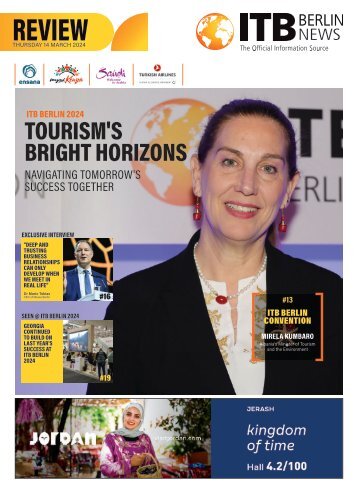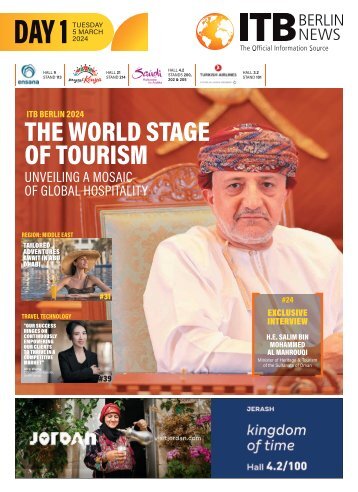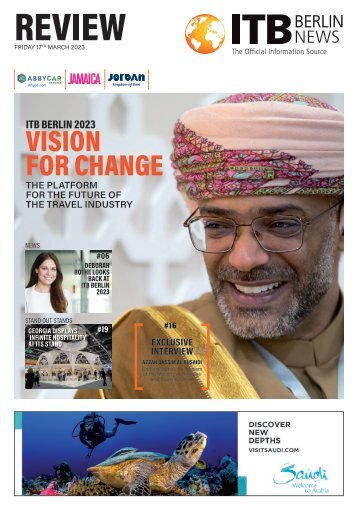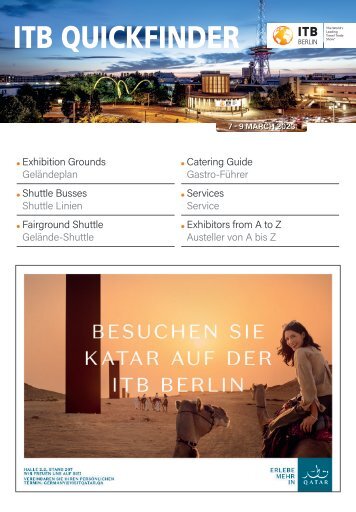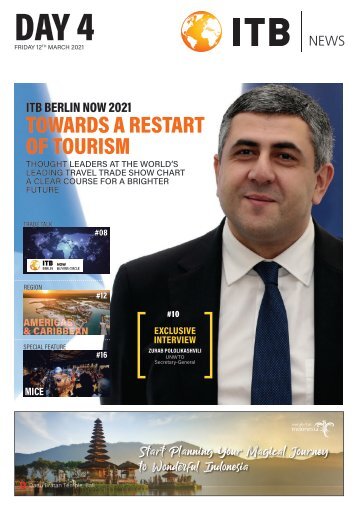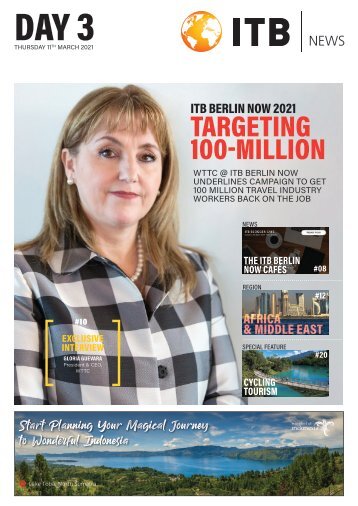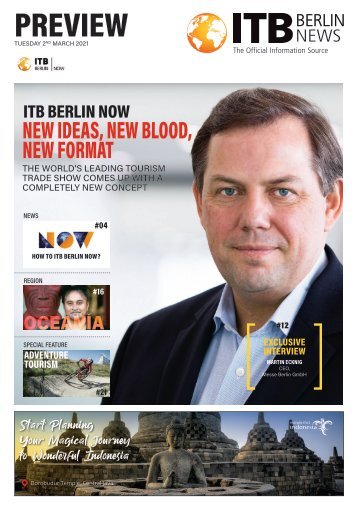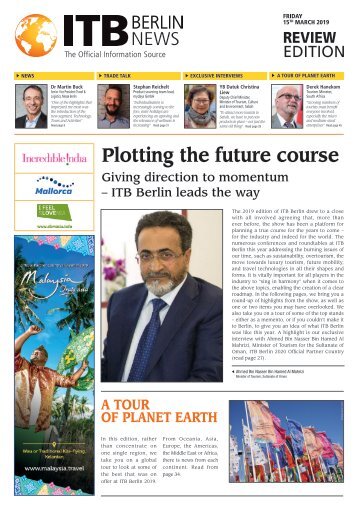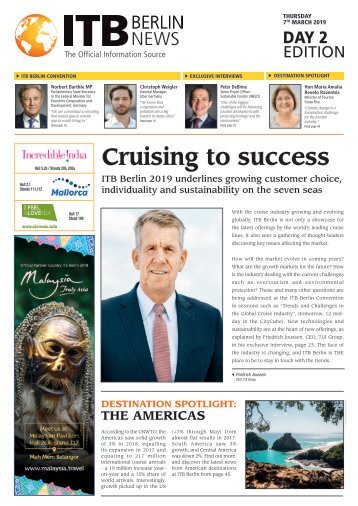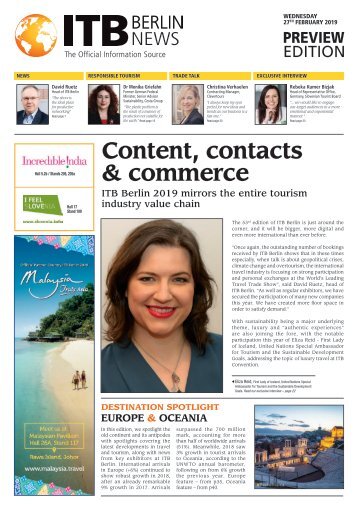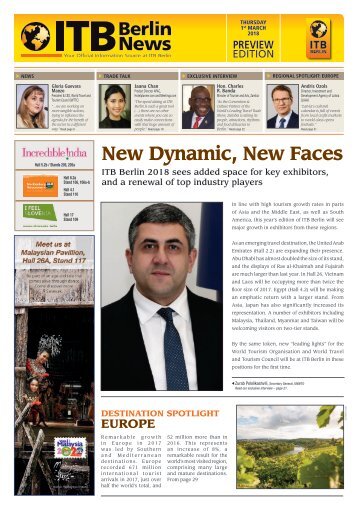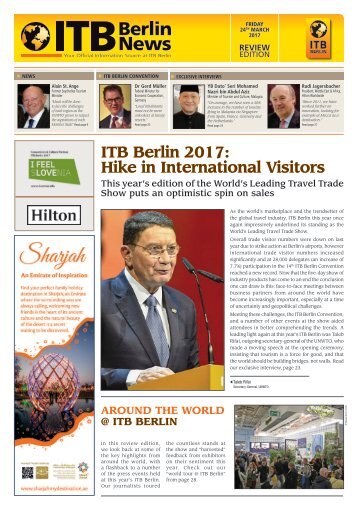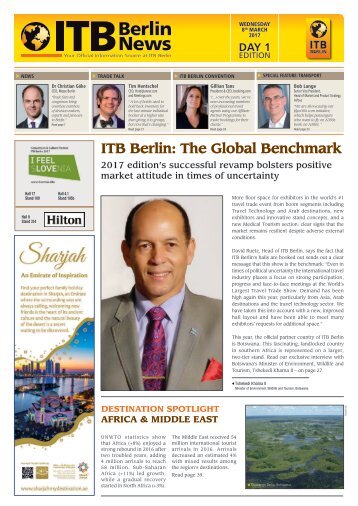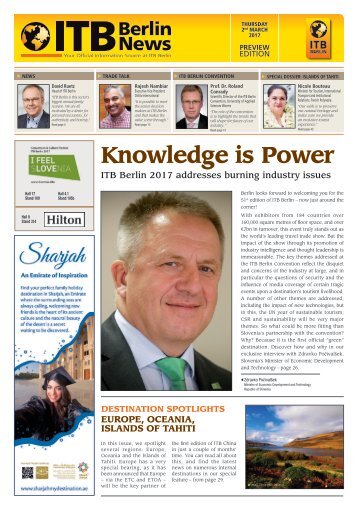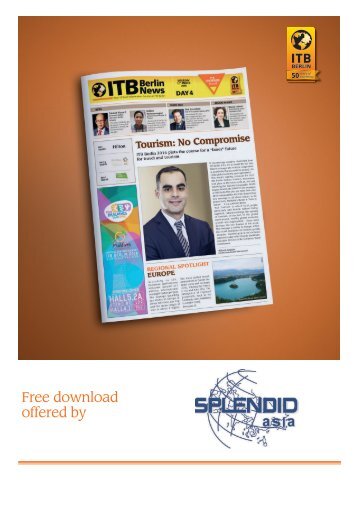
ITB Berlin News - Day 2
- Text
- Berlin
- Tourism
- Destination
- Germany
- Luxury
- European
- Hotels
- Countries
- Destinations
- Arrivals
- Www.cleverdis.com
20 REGION EUROPE
20 REGION EUROPE Regional Overview: European tourism exceeds industry expectations in 2012 Inbound tourism to Europe is expected to have grown by between 3% and 4% in 2012 following a year of strong growth in 2011 (+7%), despite the fragile eurozone economy and the slow recovery of employment. The World Tourism Organisation (UNWTO) puts the total volume of arrivals in Europe at 535 million, 17 million more than in 2011, or +3% – one point lower growth than the 4% estimated by the European Travel Commission (ETC). Whatever the final figure, both organisations agree that Europe performed well above initial expectations. And tourism remains one of the few economic growth sectors in the region. Long-haul demand for travel to European destinations remained remarkably robust and demand from some traditionally small emerging markets picked up strongly, albeit from low bases. An increasing number of Europeans also opted for travel within the region, consistent with behaviour in periods of economic weakness, when lower-cost travel options are sought, including shorter trips taken closer to home. This trend is confirmed by air passenger data, with regional travel comprising a rising share of European outbound demand in 2012. However, the sense of economic malaise reduced demand for travel among neighbouring countries in the southern eurozone and, more generally, damaged the business environment for tourism in the affected countries. Arrivals in Germany, Austria and many countries in Central & Eastern Europe were much more buoyant. Preference for shorter trips Trends in foreign visitor nights reported by ETC nevertheless highlight a slow but steady decline in average length of stay in European destinations, confirming the trend to lower-cost trips. Notable exceptions to this trend were Bulgaria (+8%), Serbia (+8%), Malta (+7%) Croatia (+7%), Spain (+7%), Latvia (+6%) and Italy (+2%), where foreign overnights grew at a faster pace than arrivals. Northern Europe In Northern Europe arrivals did little more than stagnate after relatively modest results in both 2010 and 2011. The star performer in the region by a wide margin was Iceland (+17% through 11 months), reflecting the combination of an exchange rate that is still extremely competitive, and marketing success in making an unlikely destination highly fashionable. In second place was Finland (+6% from Jan-Nov), which reports very large declines in arrivals from markets in the southern eurozone (eg Spain and Italy), balanced by large increases from Russia and more moderate increases from northern eurozone markets, the UK, Japan and China. It is likely that this general pattern Development of Outbound Trips - Poor vs Rich - was repeated across the Nordic countries, but overall there was only a modest increase in Denmark (+2%) and moderate declines in Norway (-2%) and Sweden (-2%) – all reporting 11 months of results – with steeper declines in the later months of the year. In Northern Ireland, the Loyalist protests in recent months are believed to have damaged tourist arrivals (+0.2). In the UK, in line with traditional patterns in ‘big event years’, tourist arrivals fluctuated through the year with exceptional events like the Diamond Jubilee celebrations and Summer Olympics. But they ended up flat overall (+0.3%). Preliminary indications point to a decline in arrivals from the weaker eurozone countries (-1%), but a 2% rise from the USA, and +10% from other (mainly longhaul) markets. Western Europe Arrivals in Western Europe (+3%) were rather stronger than those in Northern Europe. The best performances came from Germany (+8%), Austria (+5%) and the Netherlands (+4%), for periods varying from nine to 11 months. Most other countries achieved increases of only 1-2%, and there was a slight decline in Switzerland – due largely to the strong Swiss franc. Anecdotal evidence suggests that Germanic countries are generally more positive than the Latin countries. The weakness of the euro clearly contributed to boosting tourism from the USA, the UK and more distant countries, but reports suggest that British tourists remained cautious about their spending. Central & Eastern Europe Arrivals in Central & Eastern Europe rose strongly in 2012, by 8%, after an equally good performance in 2011. This is a very diverse sub-region, but even among close neighbours there were big variations in growth rates. By way of example, arrivals in Poland were up 13% in the first half of the year, while those in Hungary (damaged perhaps by the closure of Malev Hungarian Airlines early in the year) only rose 3%. Lithuania’s increased 12% in Jan-Oct, but Latvia and Estonia managed just 3-4%. In Estonia’s case, this can be attributed to strong base figures in 2011, when Tallinn was European Capital of Culture. International tourism to Russia is at last showing signs of solid growth, with increases of 12% in 2011 and 13% in the first three quarters of 2012. The impact of the Federal Tourism Development Programme (launched in 2011) remains uncertain, however. Arrivals in Georgia continue to soar – up 39% in 2011 and 56% in 2012 – and, at 4.4 million, make it a worthy competitor in the region. Southern / Mediterranean Europe In Southern/Mediterranean Europe there were inevitably mixed results. Overall, arrivals were up only 2%, after a strong performance in 2011. Most countries in the Balkans did ITB BERLIN NEWS • Thursday 7 th March 2013 www.itb-berlin-news.com
EUROPE REGION 21 Europe well, but arrivals in Greece were down 5.5% from Jan- Oct, bringing no relief to a stricken economy which is heavily dependent on tourism. Arrivals in Cyprus (+3%) rose in the middle part of the year, but apparently collapsed in Q4, while, in Turkey (+2%), tourism was much less buoyant than the destination has become used to, essentially because the conflict in Syria is damaging tourism in surrounding countries. Arrivals in western Mediterranean countries were generally flat (Italy) or up only modestly (Spain +3%, Portugal +4% and Malta +2%). Some industry observers in Italy are positive, especially about arrivals from the BRICS, but the general economic malaise in the region is holding back tourism among neighbouring countries, especially in Spain and Portugal. Many are preoccupied with economic decline, increases in taxation and problems in the local business environment. Key source markets Among the leading intraregional source markets (the topic of the IPK International World Travel Trends Report at the ITB Convention on Wednesday), Germany continued to grow throughout much of 2012, although growth was primarily to the typically smaller East European destinations. A shorter length of stay was consistent with lower consumer confidence and cost savings being sought by travellers. Both UNWTO and ETC expect Europe’s inbound tourism to grow on average by 1 to 3% in 2013 Outbound travel from the Netherlands followed a similar pattern but the Dutch exhibited even more caution. Falling arrivals were reported by a greater number of destinations, with falls of a large magnitude. French demand also slowed as 2012 progressed, in line with economic growth, but performance for leading destinations was mixed. The majority reported a higher number of French visitors but several large destinations, including the UK, reported falling French demand. Italian tourism demand was weaker still. More destinations reported fewer Italian arrivals and nights than reported growth, but within this there was some exceptionally high growth, notably to Cyprus and Serbia, but it should be noted that these are lowvolume markets and not reflective of overall demand. Tourism demand from the UK was very mixed during the year, and altogether flat in terms of growth, but Europe generally benefited at the expense of long-haul destinations. Russia remains a top performing source market with the overwhelming majority of destinations reporting strong growth in arrivals in 2012. Continuing high oil prices have benefited the Russian market and, subsequently, tourism demand. The rejuvenation of the economies in key long-haul markets also contributed to the growth of international arrivals in Europe. Most European destinations reported robust growth from the USA, coupled with a strong rebound of the Japanese market after the events of 2011. The weaker euro, especially relative to the US dollar, also had a positive impact. Current prospects Tourism remains one of the few economic sectors proving resilient in the fragile economies of Europe. 15 12.3 15.1 25 32.6 The European Commission expects economic growth to gradually return in the EU during 2013, with further strengthening appearing only in 2014. Both UNWTO and ETC expect Europe’s inbound tourism to grow on average by 1 to 3% in 2013, with marked differences across destinations. [by nancy cockerell] Five Types of tourists - Percentage of Type - International tourist arrivals* in Europe by sub-region, 2011-12 (mn) % annual 2011 2012 change % share Northern Europe 64.8 65.1 0.4 12.2 Western Europe 161.0 165.8 3.0 31.0 Central/Eastern Europe 105.3 113.7 8.0 21.3 Southern/Mediterranean Europe 186.4 190.2 2.0 35.5 of which: EU27 390.9 400.1 2.3 74.8 Total Europe 517.5 534.8 3.3 100.0 * Preliminary results for 2012 as at Feb 2013 Source: World Tourism Barometer, Jan 2013, World Tourism Organization (UNWTO) ITB BERLIN NEWS • Thursday 7 th March 2013
- Page 1: THURSDAY 7 th MARCH 2013 DAY2 EXCLU
- Page 6 and 7: 6 NEWS ITB Berlin 2013 - An State l
- Page 9: ITB Berlin CONVENTION 9 The Power o
- Page 14 and 15: 14 NEWS ADVERTORIAL Prohibition Day
- Page 17: EXCLUSIVE INTERVIEW 17 TUI Targets
- Page 22 and 23: 22 REGION EUROPE Germany Highlights
- Page 24 and 25: 24 REGION EUROPE Europe’s Culture
- Page 26 and 27: 26 REGION EUROPE ITB BERLIN NEWS
- Page 29: LUXURY TRAVEL SPECIAL FEATURE 29 AD
- Page 33: LUXURY TRAVEL SPECIAL FEATURE 33 A
- Page 37 and 38: LUXURY TRAVEL SPECIAL FEATURE 37 AD
- Page 39: CRUISES SPECIAL FEATURE 39 All Aboa
- Page 42 and 43: 42 ONLINE Mobile Apps are Key to Gr
- Page 45 and 46: 45 HOSPITALITY / RESTAURANTS / BARS
Inappropriate
Loading...
Mail this publication
Loading...
Embed
Loading...
